Message to Observer
Battery(ies) to fire for effect
Adjusting battery
Changes to the initial call for fire
Number of rounds (per tube) to be fired for effect
Target numbers
Additional information:
Time of flight; Probable error in range (normally 38 meters or greater); Angle T (500 mils or greater)
Correction of errors—if the FDC makes an error when reading back the fire support data, announce “Correction” and re-transmit the correct data in its entirety.
CALL-FOR-FIRE TRANSMISSIONS
A soldier or FO must determine the best method—grid mission, polar mission, or shift from a known point—for sending a call-for-fire transmission.
Grid Mission
In a grid mission, the observer sends the target location as a six-digit grid. Before the first adjusting rounds are fired, the FDC must know the direction from the observer’s location. The observer sends observer-target (OT) direction (to the nearest 10 mils) from his position to the target. OT is the direction in mils from the observer to the target.
GRID MISSION
Observer
Fire Support Unit
“A66 this is Z33, adjust fire, over.”
“Z33 this is A66, adjust fire out.”
“Grid AA12345678, direction 0530, over.”
“Grid AA12345678, direction 0530, out.”
“Infantry platoon in the open, over.”
“Infantry platoon in the open, out.”
“Shot, out.”
“Shot, over.”
“Splash, over.”
“Splash, out.”
“End of mission, 10 casualties, platoon dispersed, over.”
“End of mission, 10 casualties, platoon dispersed, out.”
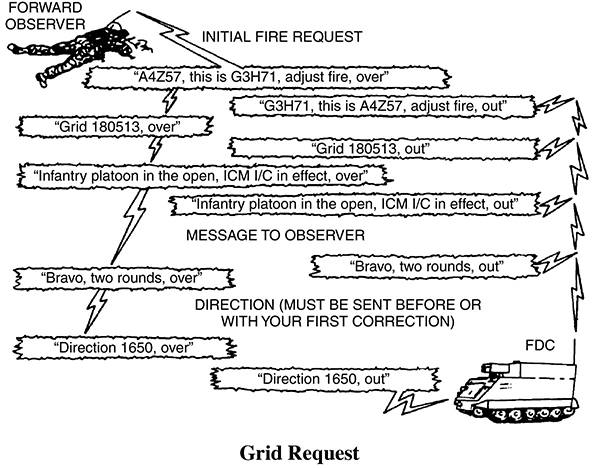
Polar Mission
For a polar mission, the observer sends a direction, distance, and an up or down measurement (vertical shift) to the target. The word “polar” in the warning order alerts the FDC that the target will be located with respect to the observer’s position, which must be known by the FDC. A vertical shift tells the FDC how far in meters the target is located above or below the observer’s location.
POLAR MISSION
Observer
Fire Support Unit
Fire for effect, polar, over
Fire for effect, polar, out
Direction 4520, distance 2300, down 35, over
Direction 4520, distance 2300, down 35, out
Infantry company in the open, over
Infantry company in the open, out
3 rounds target, over
3 rounds target, out
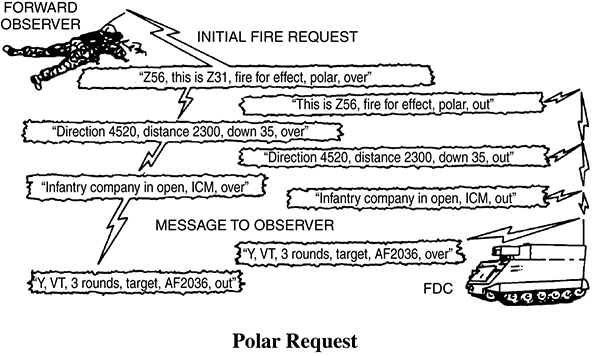
Shift from a Known Point
In a shift from a known point mission, the point or target from which the shift will be made is sent in the warning order. Both the observer and the FDC must know the point. The observer sends a target/registration point number, an OT direction, a right or left correction (lateral shift), an add or drop correction to the nearest 100 meters (range shift), and an up or down correction (vertical shift) from the known point to the target. Normally, the OT direction is sent in mils, but the FDC can accept degrees or cardinal direction if that is all the observer can send. The lateral shift is how far left or right the target is from the known point. The range shift is how much farther (add) or closer (drop) the target is from the known point. The vertical shift is how much the target is above (up) or below (down) the altitude of the known point, to the nearest 5 meters (the vertical shift is ignored unless it exceeds 30 meters).
SHIFT FROM A KNOWN POINT
Observer
Fire Support Unit
“A66 this is Z33, adjust fire, shift BB1001, over.”
“Z33 this is A66, adjust fire, shift BB1001, out.”
“Direction 2420, right 300, add 400, over.”
“Direction 2420, right 300, add 400, out.”
“Two armored vehicles at POL site, over.”
“Two armored vehicles at POL site, out.”
“Authenticate Juliet November, over.”
“I authenticate Tango, out.”
“Shot, out.”
“Shot, over.”
“Splash, over.”
“Splash, out.”
“End of mission, 2 vehicles destroyed, over.”
“End of mission, 2 vehicles destroyed, out.”
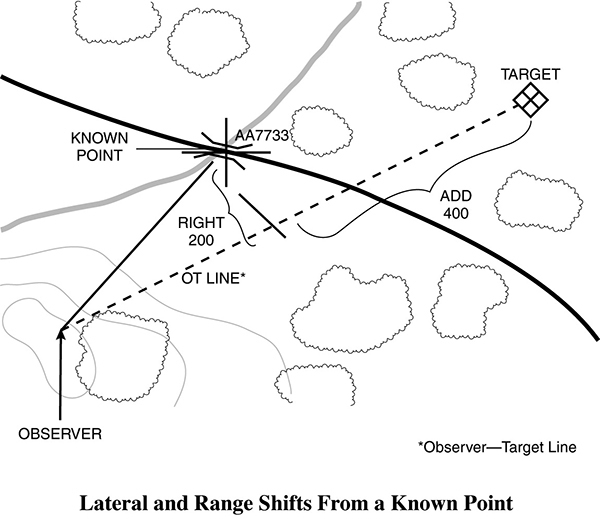
ADJUSTING FIRE
To adjust fire onto a target, use the bracketing method of adjustment. Spot each round when it impacts as over or short, right or left of the target. When the first range spotting is observed, make a range correction that would result in a range spotting in the opposite direction. For example, if the first round is short, add enough range to get an over on the next round.
Use the following guide to establish a bracket:
Round Impact from Target
Add or drop + or -
Over 400 meters
800 meters + or -
200–400
400 meters + or -
100–200 meters
200 meters + or -
Less than 100 meters
100 meters
1.To find deviation, measure the horizontal angle in mils, using either fingers or the reticle pattern in the binoculars. Estimate the range to the target and divide by 1,000. This is the observer target (OT) factor. If the OT distance is 1,000 meters or greater, the OT factor is expressed to the nearest whole number. If the OT distance is less than 1,000 meters, the OT factor is expressed to the nearest tenth. For example, 800 = 0.8. Multiplying the OT factor by the deviation measured in mils produces deviation in meters.
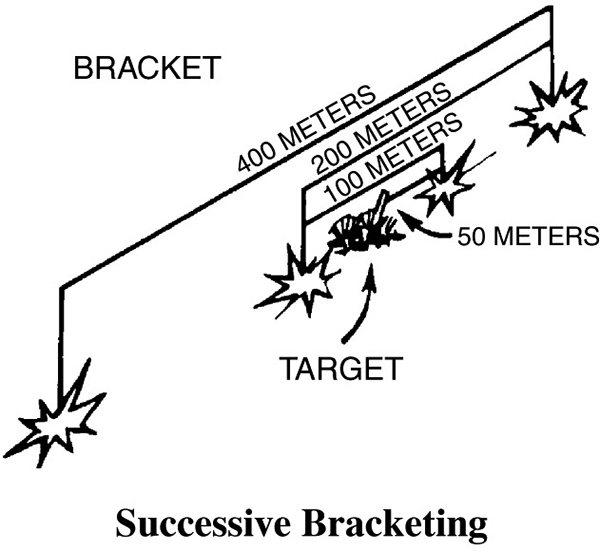
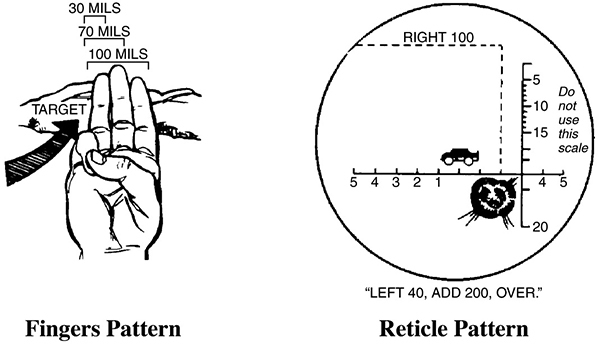
For example, if we measure the round 100 mils right of the target and estimate the range to be 2,200 meters, the OT factor is 2. For adjustment purposes, we express the OT factor to the nearest whole number. Example: 1.1 would be 1; 1.8 would be 2; 2.5 would be 2. Multiplying the angle (100 mils) by the OT factor (2), we get the deviation in meters (200 meters right).
2.Transmit corrections to the FDC in meters. The initial correction should bracket the target in range. Deviation correction should be made to keep the rounds on the observer target line. The accompanying figure shows the impact of the initial round. Since the round is beyond the target, you must drop. You estimate that the round is 250 meters beyond the target. Therefore, a 400-meter drop will give you a bracket. The round impacted 50 mils left of the target. With an OT factor of 2, the round impacted 100 meters left. Your correction to the FDC is “Right 100, drop 400, over.”
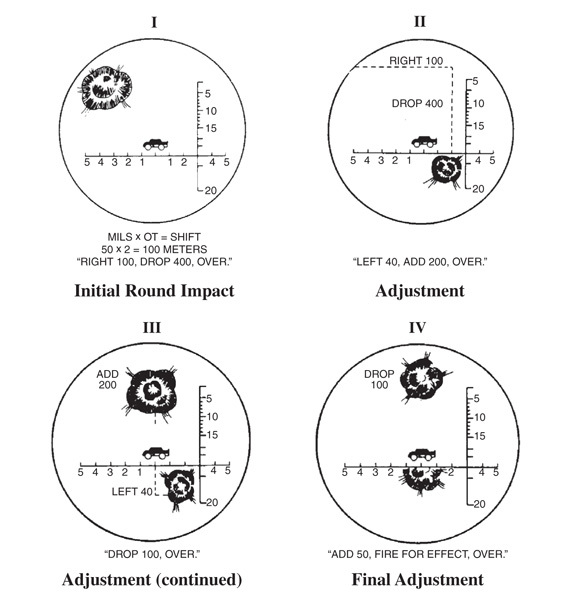
3.Continue splitting the range bracket until a 100-meter bracket is split or a range correct spotting is observed, maintaining deviation on line.
4.Initiate fire for effect. When a 100-meter bracket is split or a range correct spotting is made, the fire-for-effect phase is entered, and the call is “Fire for effect.”
5.Observe the results of fire for effect and report the results. When the smoke clears, tell the FDC what the results are. Such things as the number of casualties, damaged equipment, stalled tracks, and so forth are important.
LESSONS LEARNED DURING OPERATION ENDURING FREEDOM
The following text comes from a series of small infantry unit After Action Reviews on indirect-fire support in Afghanistan.
Mortars at Company and Battalion Level
Despite the desire to go in light, mortars are essential for mountain warfare. Mortars were used to destroy visible targets at long ranges, immediate target engagement, and to cover the abundance of dead space. Mortar platoon members in some units carried 5 rounds per person and every soldier carried 2 rounds. Since the mortars were not static, but had to move positions (sometimes rapidly) several leaders remarked that it worked well in their situation to not have everyone drop off all their rounds at the mortar position. In other words, if the rounds were immediately brought to the mortar position, when they moved it would have been impossible to relocate them with the tubes.